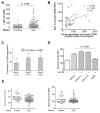Monocyte surface expression of Fcgamma receptor RI (CD64), a biomarker reflecting type-I interferon levels in systemic lupus erythematosus
- PMID: 20478071
- PMCID: PMC2911874
- DOI: 10.1186/ar3017
Monocyte surface expression of Fcgamma receptor RI (CD64), a biomarker reflecting type-I interferon levels in systemic lupus erythematosus
Abstract
Introduction: More than half of systemic lupus erythematosus (SLE) patients show evidence of excess type I interferon (IFN-I) production, a phenotype associated with renal disease and certain autoantibodies. However, detection of IFN-I proteins in serum is unreliable, and the measurement of interferon-stimulated gene (ISG) expression is expensive and time consuming. The aim of this study was to identify a surrogate marker for IFN-I activity in clinical samples for monitoring disease activity and response to therapy.
Methods: Monocyte surface expression of Fcgamma receptors (FcgammaRs), chemokine receptors, and activation markers were analyzed with flow cytometry in whole blood from patients with SLE and healthy controls. FcgammaR expression also was measured in peripheral blood mononuclear cells (PBMCs) from healthy controls cultured with Toll-like receptor (TLR) agonists, cytokines, or serum from SLE patients. Expression of ISGs was analyzed with real-time PCR.
Results: Circulating CD14+ monocytes from SLE patients showed increased surface expression of FcgammaRI (CD64). The mean fluorescent intensity of CD64 staining correlated highly with the ISG expression (MX1, IFI44, and Ly6E). In vitro, IFN-I as well as TLR7 and TLR9 agonists, induced CD64 expression on monocytes from healthy controls. Exposure of monocytes from healthy controls to SLE sera also upregulated the expression of CD64 in an IFN-I-dependent manner. Decreased CD64 expression was observed concomitant with the reduction of ISG expression after high-dose corticosteroid therapy.
Conclusions: Expression of CD64 on circulating monocytes is IFN-I inducible and highly correlated with ISG expression. Flow-cytometry analysis of CD64 expression on circulating monocytes is a convenient and rapid approach for estimating IFN-I levels in SLE patients.
Figures





Comment in
-
A new tool for detection of type I interferon activation in systemic lupus erythematosus.Arthritis Res Ther. 2010;12(4):138. doi: 10.1186/ar3114. Epub 2010 Aug 26. Arthritis Res Ther. 2010. PMID: 20815919 Free PMC article.
Similar articles
-
Increased expression of FcgammaRI/CD64 on circulating monocytes parallels ongoing inflammation and nephritis in lupus.Arthritis Res Ther. 2009;11(1):R6. doi: 10.1186/ar2590. Epub 2009 Jan 14. Arthritis Res Ther. 2009. PMID: 19144150 Free PMC article.
-
Expression of CD64 on Surface of Circulating Monocytes in Systemic Lupus Erythematosus Patients: Relation to Disease Activity and Lupus Nephritis.Egypt J Immunol. 2017 Jan;24(1):67-78. Egypt J Immunol. 2017. PMID: 29120579
-
TBK1: A key regulator and potential treatment target for interferon positive Sjögren's syndrome, systemic lupus erythematosus and systemic sclerosis.J Autoimmun. 2018 Jul;91:97-102. doi: 10.1016/j.jaut.2018.02.001. Epub 2018 Apr 16. J Autoimmun. 2018. PMID: 29673738
-
Type I interferon pathway in pediatric systemic lupus erythematosus.World J Pediatr. 2024 Jul;20(7):653-668. doi: 10.1007/s12519-024-00811-4. Epub 2024 Jun 25. World J Pediatr. 2024. PMID: 38914753 Free PMC article. Review.
-
Cluster of highly expressed interferon-stimulated genes associate more with African ancestry than disease activity in patients with systemic lupus erythematosus. A systematic review of cross-sectional studies.Transl Res. 2021 Dec;238:63-75. doi: 10.1016/j.trsl.2021.07.006. Epub 2021 Jul 31. Transl Res. 2021. PMID: 34343626
Cited by
-
Protein and DNA methylation-based scores as surrogate markers for interferon system activation in patients with primary Sjögren's syndrome.RMD Open. 2020 Jan;6(1):e000995. doi: 10.1136/rmdopen-2019-000995. RMD Open. 2020. PMID: 31958277 Free PMC article.
-
Expression of an anti-RNA autoantibody in a mouse model of SLE increases neutrophil and monocyte numbers as well as IFN-I expression.Eur J Immunol. 2014 Jan;44(1):215-26. doi: 10.1002/eji.201343714. Epub 2013 Oct 21. Eur J Immunol. 2014. PMID: 24105635 Free PMC article.
-
Development and Validation of an Ultrasensitive Single Molecule Array Digital Enzyme-linked Immunosorbent Assay for Human Interferon-α.J Vis Exp. 2018 Jun 14;(136):57421. doi: 10.3791/57421. J Vis Exp. 2018. PMID: 29985347 Free PMC article.
-
Differential Accumulation and Activation of Monocyte and Dendritic Cell Subsets in Inflamed Synovial Fluid Discriminates Between Juvenile Idiopathic Arthritis and Septic Arthritis.Front Immunol. 2020 Jul 31;11:1716. doi: 10.3389/fimmu.2020.01716. eCollection 2020. Front Immunol. 2020. PMID: 32849606 Free PMC article.
-
Immune dysregulation and multisystem inflammatory syndrome in children (MIS-C) in individuals with haploinsufficiency of SOCS1.J Allergy Clin Immunol. 2020 Nov;146(5):1194-1200.e1. doi: 10.1016/j.jaci.2020.07.033. Epub 2020 Aug 25. J Allergy Clin Immunol. 2020. PMID: 32853638 Free PMC article.
References
-
- Baechler EC, Batliwalla FM, Karypis G, Gaffney PM, Ortmann WA, Espe KJ, Shark KB, Grande WJ, Hughes KM, Kapur V, Gregersen PK, Behrens TW. Interferon-inducible gene expression signature in peripheral blood cells of patients with severe lupus. Proc Natl Acad Sci USA. 2003;100:2610–2615. doi: 10.1073/pnas.0337679100. - DOI - PMC - PubMed
-
- Feng X, Wu H, Grossman JM, Hanvivadhanakul P, FitzGerald JD, Park GS, Dong X, Chen W, Kim MH, Weng HH, Furst DE, Gorn A, McMahon M, Taylor M, Brahn E, Hahn BH, Tsao BP. Association of increased interferon-inducible gene expression with disease activity and lupus nephritis in patients with systemic lupus erythematosus. Arthritis Rheum. 2006;54:2951–2962. doi: 10.1002/art.22044. - DOI - PubMed
-
- Kirou KA, Lee C, George S, Louca K, Papagiannis IG, Peterson MG, Ly N, Woodward RN, Fry KE, Lau AY, Prentice JG, Wohlgemuth JG, Crow MK. Coordinate overexpression of interferon-alpha-induced genes in systemic lupus erythematosus. Arthritis Rheum. 2004;50:3958–3967. doi: 10.1002/art.20798. - DOI - PubMed
-
- Zhuang H, Narain S, Sobel E, Lee PY, Nacionales DC, Kelly KM, Richards HB, Segal M, Stewart C, Satoh M, Reeves WH. Association of anti-nucleoprotein autoantibodies with upregulation of type I interferon-inducible gene transcripts and dendritic cell maturation in systemic lupus erythematosus. Clin Immunol. 2005;117:238–250. doi: 10.1016/j.clim.2005.07.009. - DOI - PubMed
Publication types
MeSH terms
Substances
Grants and funding
LinkOut - more resources
Full Text Sources
Other Literature Sources
Medical
Research Materials

